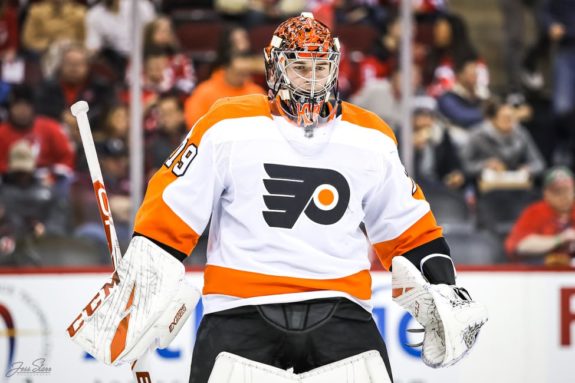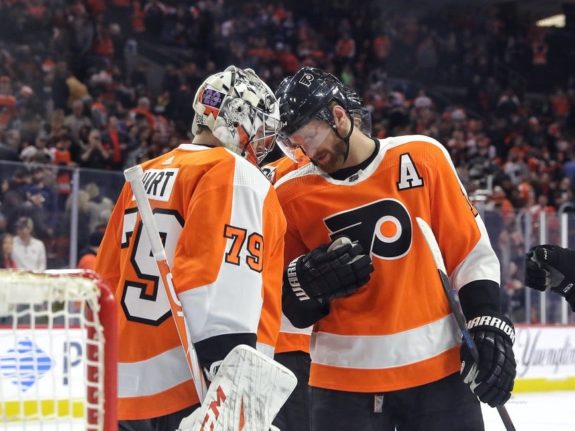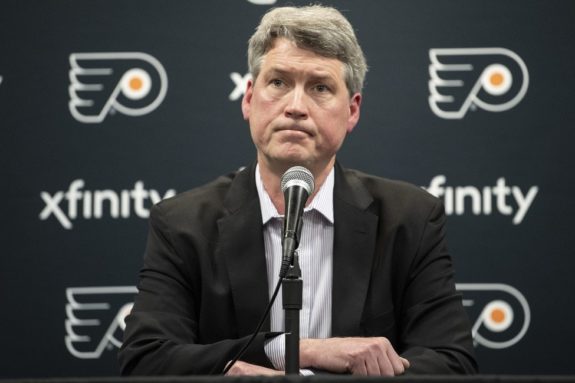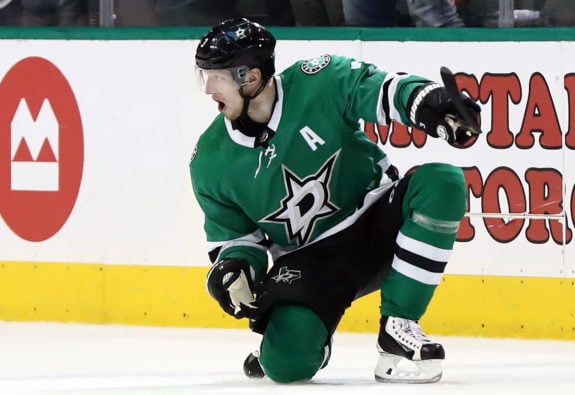The Philadelphia Flyers suffered an embarrassing 9-0 blowout loss to the New York Rangers on Wednesday in which their season-long inadequacies came to full display. It was their sixth loss in nine tries before a recovery win against the New York Islanders at Nassau Coliseum on Thursday. The problems this Flyers team faces are rampant. The defensive corps has been extremely disappointing, and the collective defensive effort is glaringly unreliable.
The goaltending has been inconsistent, as 22-year-old Carter Hart continues to struggle while Brian Elliott has cooled off after a hot streak to begin the season. Regardless of shortcomings, they currently sit in the fifth spot in the MassMutual East Division, still with an opportunity to make a playoff push.

General manager Chuck Fletcher has key evaluations to make prior to the upcoming trade deadline on April 12. Trade deadline moves often indicate whether a franchise is fixated on an upcoming postseason run or looking to focus more on long-term goals. Despite their early-season struggles, the Flyers need to be aggressive in making an acquisition benefitting the current roster given their franchise trajectory over the past nine years and their unique organizational blend of young talent and aging talent.
Franchise Trajectory
The Flyers went seven consecutive seasons from 2012-13 through 2018-19 without winning a postseason series. The drought consisted of opening-round exits to the New York Rangers in the 2014 Playoffs, the Washington Capitals in the 2016 Playoffs, and the Pittsburgh Penguins in the 2018 Playoffs. Each of the three respective opponents featured elite NHL talent that stifled overmatched Flyers teams. A Philadelphia fanbase accustomed to competitive hockey prior to the NHL lockout following the 2011-12 season endured the longest span between postseason series victories in franchise history.
The Flyers entrusted former goaltender Ron Hextall with general manager duties in May 2014 with hopes for a franchise rebuild. Hextall’s draft picks and player development strategies during his management tenure in Philadelphia are currently looked on positively in most NHL circles. However, the tenure ended in Nov 2018, while the rebuilding process within the organization seemed to be moving along at an overly tedious pace.
As Philadelphia moved forward into the tenure of Fletcher and the first season under head coach Alain Vigneault in 2019-20, the Flyers appeared poised to begin a new era. They finally snapped their streak of playoff futility with a series victory over the Montreal Canadiens in the Eastern Conference Quarterfinals in the Toronto bubble last season. Young, homegrown Flyers talent like Ivan Provorov, Hart, Travis Konecny, and Joel Farabee joined forces with veterans Claude Giroux, Jake Voracek, and Sean Couturier and found tremendous team chemistry aided by the additions of Kevin Hayes and Matt Niskanen.

Despite a loss to the Islanders in the ensuing round, optimism swirled among the fanbase. The rebuild appeared to have finally come to fruition. The Flyers returned the majority of their key contributors from last season. They looked primed to contend for the East Division and a Stanley Cup entering the 2020-21 season.
Now Is the Time
The asset management during the rebuild was long and arduous, especially for a franchise with as rich of a history as the Philadelphia Flyers. Hextall’s patient philosophy included severe hesitation to forfeit draft capital or unpolished prospects for proven NHL talent. The most significant deadline acquisitions for the Flyers during his tenure were underwhelming names like Radko Gudas, Valtteri Filppula, and Petr Mrazek.
While Hextall’s approach benefitted the organization from a long-term standpoint in many ways, but Fletcher should not take the same approach. The purpose of allocating organizational resources towards the future is to eventually build a team with the talent level that the Flyers currently own. Fletcher needs to recognize the franchise trajectory in his evaluation of the 2020-21 team, and he should be willing to make a significant move prior to the deadline if it means losing draft picks or prospects in exchange for proven NHL talent.
The struggles of young players, namely Hart, and the inability to fill the void left by Niskanen’s retirement should not convince the Flyers to sway from the confidence they built after taking a major step forward last season (Flyers at the halfway point: Can they make the playoffs out of the tough East Division?, The Philadelphia Inquirer, 18/03/21). While the first half of the shortened 2020-21 season has not turned out the way the Flyers hoped, they still sit in striking distance of a playoff spot with more than enough opportunities to gain ground in head-to-head matchups against division opponents currently sitting in playoff position.
The case can be made for the Flyers to stand pat at the deadline. Their struggles during the first half of the season have led many to believe the team is not one player away from Stanley Cup contention, and young players fitting into the organization’s long-term plans can be found up and down the roster. The salary cap uncertainty and looming expansion draft this summer also aren’t making matters easy on current NHL general managers. However, the Flyers also need to consider the shrinking window of opportunity for their veteran contributors.

The 33-year-old Giroux is only under contract through the 2021-22 season, and the 31-year-old Voracek is no guarantee to stay in Philadelphia past the expansion draft. Both players are invaluable to the organization, and their respective career trajectories should factor into the organization’s plans just as much as the young corps of talent built during Hextall’s tenure.
On the Horizon
Fletcher has options for trade partners to improve the Flyers’ roster, especially on the blue line. Mattias Ekholm of the Nashville Predators and John Klingberg of the Dallas Stars highlight the list of available names (LeBrun: 4 potential trade destinations for Mattias Ekholm, The Athletic, 20/02/21). Secondary options include Rasmus Ristolainen of the Buffalo Sabres and Alex Goligoski of the Arizona Coyotes, among others.
Ekholm is the most attractive name on the list. He would presumably be inserted immediately into a top-pair role-playing alongside Provorov despite the uncertain chemistry of two left-handed defensemen on the ice together. Klingberg, a right-handed shot, could also add top pair value and valuable veteran stability to an inexperienced group. Fletcher needs to pursue a trade aggressively, and parting ways with early-round draft picks or top prospects Morgan Frost or Tyson Foerster should not be off the table in trade discussions.

A new face would provide an opportunity to solve the woes of the Flyers blueliners. If Ekholm or Klingberg can play the role left void by Niskanen’s sudden retirement, the defensemen currently on the roster would have the pressure taken off their shoulders. They would be put into more suitable roles on the second and third pairs and eliminate the need for Vigneault to shuffle his pairs in failed attempts to compensate for Niskanen’s absence.
The Flyers will not earn a playoff berth in the East Division without major improvement in their game, and the best opportunity to find that improvement is through the acquisition of a marquee player.